blog
October 5, 2025
Can Phytoestrogens Ease Hot Flushes in Menopause?
Hot flushes and night sweats — sometimes called vasomotor symptoms — are one of the most common (and most frustrating!) parts of perimenopause and menopause. Around three in four women experience them at some point, and for about a third, they’re intense enough to interfere with daily life or sleep. It’s one reason so many women are interested in phytoestrogens and menopause, and whether plant-based compounds might help.
For some, these symptoms fade after a few years. But for many others, they hang around much longer than expected. Studies show that hot flushes can last an average of seven years or more, and a significant number of women still report symptoms well into their 60s.
One large study even found that around 40% of women aged 40–65 continue to experience moderate to severe hot flushes and night sweats.

If you’ve had one, you’ll know what it feels like — that sudden wave of heat rising through your body, flushed skin, and a rush of sweating that seems to come from nowhere. For some, they’re a passing nuisance. For others, they can strike multiple times a day (and night), disrupt sleep, and take a real toll on mood, energy, and confidence.
Why do they happen?
The exact cause isn’t completely understood, but the drop in oestrogen seems to affect the hypothalamus—the part of the brain that regulates temperature—making it far more sensitive than before. That’s why small triggers, like a warm room, a hot drink, or even stress, can set off a flush or night sweat. It’s likely that changes in the nervous system are also involved, which is why it’s not just about oestrogen.
What can we do about them?
The truth is, there’s no one-size-fits-all answer.
For some women, simple practical tweaks—wearing breathable layers, keeping a fan nearby, or using cooling sprays—are enough to take the edge off. For others, symptoms are much more disruptive. Hormone Replacement Therapy (HRT) is still the most effective treatment for vasomotor symptoms and there are other medications available if HRT isn’t right for you.
But beyond medical options, lifestyle is important too.
Body Weight and Menopause Symptoms (Hot Flushes & Night Sweats)
Body weight may influence vasomotor symptoms, with some women noticing additional weight increases the frequency and/or intensity of menopause symptoms like hot flushes and night sweats. Encouragingly, even small, gradual weight loss has been shown to help ease symptoms and improve comfort.
In one study women who lost about 5 kg (11 lbs) were more likely to see an improvement in their hot flushes — with every 5-kg drop linked to around a 30% higher odds of relief.
The Women’s Health Initiative found a similar pattern. Women who lost 10% or more of their body weight had a significantly higher chance of their hot flushes improving, and for those who lost that amount, the odds of becoming symptom-free were almost twice as high as women who kept their weight stable.
Do Coffee, Alcohol, and Spicy Foods Trigger Hot Flushes?
Some women notice that caffeine, alcohol, or spicy foods seem to make hot flushes worse — these are often listed among common ‘foods for hot flushes’ triggers — but the research isn’t very clear-cut. The evidence so far suggests there may be a link, but it varies from person to person. The best approach is to simply pay attention to how your body responds and see if cutting back on any of these makes a difference for you. Learn more here about how alcohol affects menopause symptoms in our related blog.
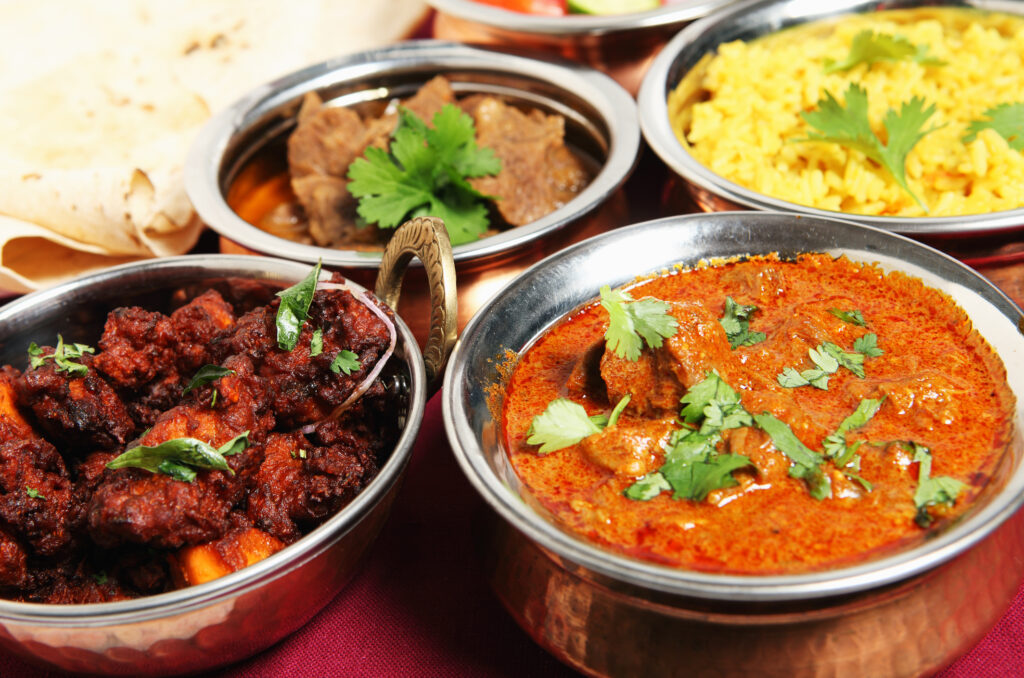
Phytoestrogens and Menopause: Can They Help Hot Flushes?
Being mindful of what to limit has its place, but the real opportunity lies in exploring foods we can eat more of.
One group that often sparks interest is phytoestrogens, sometimes called plant oestrogens. Could they really help with menopause symptoms like hot flushes and night sweats?
Let’s take a closer look.
What Are Phytoestrogens?
Phytoestrogens are natural compounds found in plants that can act a little like oestrogen in the body — the name quite literally means “plant oestrogen.”
Here’s how they work: phytoestrogens can loosely fit into oestrogen receptors in our cells (a bit like a key in a lock). This means they can send a weak oestrogen-like signal, which for some women may help ease symptoms such as hot flushes and night sweats when hormone levels begin to fall.
Types of Phytoestrogens
- Isoflavones – found mainly in soyabeans, soya products (like tofu and soya milk), and red clover.
- Lignans – especially rich in flaxseeds, but also present in wholegrains, fruit, and vegetables.
- Coumestans – found in beans such as chickpeas and pinto beans, as well as in Brussels sprouts.
Of these, isoflavones are the ones most often studied in relation to hot flushes and night sweats
Rather than being a ‘replacement’ for oestrogen, phytoestrogens act more like a gentle nudge to the system.
For some women, including them through food (or sometimes supplements) can make a noticeable difference to symptoms. For others, the effect is less obvious — it really does vary from person to person.
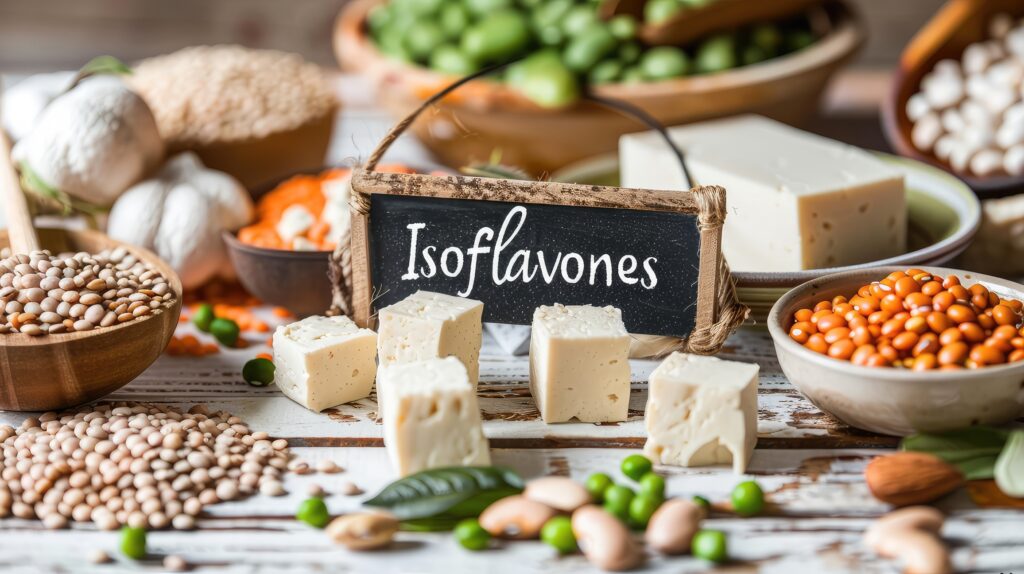
Foods Rich in Phytoestrogens (Soya, Flaxseed, and More)
You don’t have to search far to find phytoestrogens. They show up in a wide range of foods — from beans, seeds, fruit, and veg, to soya products like tofu, tempeh, and soya milk. These foods are an easy way to bring more phytoestrogens into your menopause diet.
Of course, not all foods contain the same amount — some are real standouts.
Here’s a quick guide to give you a sense of where phytoestrogens show up, and in what amounts:
Table of Foods (soya, flax etc.)
| Food | Serving size | Approx. phytoestrogen content |
| Soyabeans (cooked) | 80–90 g (½ cup) | 55–60 mg isoflavones |
| Tofu | 100 g | 25–30 mg isoflavones |
| Edamame | 150 g (1 cup pods) | 25–30 mg isoflavones |
| Soya milk | 250 ml (1 cup) | 20–30 mg isoflavones |
| Tempeh | 85–90 g (½ cup) | 35–40 mg isoflavones |
| Soya yoghurt | 130 g (½ cup) | 20–25 mg isoflavones |
| TVP (textured vegetable protein, dry) | 30–40 g | ~70 mg isoflavones (≈20 g soya protein) |
| Rule of thumb | — | 1 g soya protein ≈ 3.5 mg isoflavones |
| Flaxseed | 1 tbsp (10–15 g) | ~25 mg lignans |
| Sesame seeds | 30 g | ~2.7 mg lignans |
| Tahini | 30 g (2 tbsp) | ~2–3 mg lignans |
| Chickpeas | ½ tin (~120 g drained) | ~2 mg phytoestrogens |
| Dates | 100 g | 0.6 mg phytoestrogens |
| Figs | 100 g | 0.4 mg phytoestrogens |
| Pomegranate | 100 g | 0.3 mg phytoestrogens |
| Prunes (ready to eat) | 100 g | 0.3 mg phytoestrogens |
| Sweet potatoes | 100 g | 0.3 mg phytoestrogens |
Soya foods clearly top the list — tofu, tempeh, soya milk, and edamame are all rich in isoflavones, the type of phytoestrogen studied most for menopause symptoms. Flaxseed is another star player, packing a generous dose of lignans into just a spoonful or two.
Other plant foods like chickpeas, wholegrains, fruit, and veg contain phytoestrogens too, but in much smaller amounts. They’re still fantastic for overall health, but on their own they’re unlikely to make a big difference when it comes to hot flushes and night sweats.
Do Phytoestrogens Help with Hot Flushes?
A standout study
One of the most interesting trials in recent years tested a low-fat vegan diet with a daily serving of soyabeans (about half a cup cooked).
After just 12 weeks, women eating the soyabeans reported an 88% drop in moderate-to-severe hot flushes, and half said those intense flushes had stopped completely. On top of that, participants lost an average of 3–4 kg in weight. What underlies this change isn’t entirely clear and we need larger scale studies to confirm these findings. It may have been the soyabeans alone, the overall shift to a more plant-based, low-fat diet, the weight loss, or most likely a mix of all these factors. Either way, it’s a fascinating result that highlights the potential of diet and lifestyle changes to reduce menopause symptoms naturally.
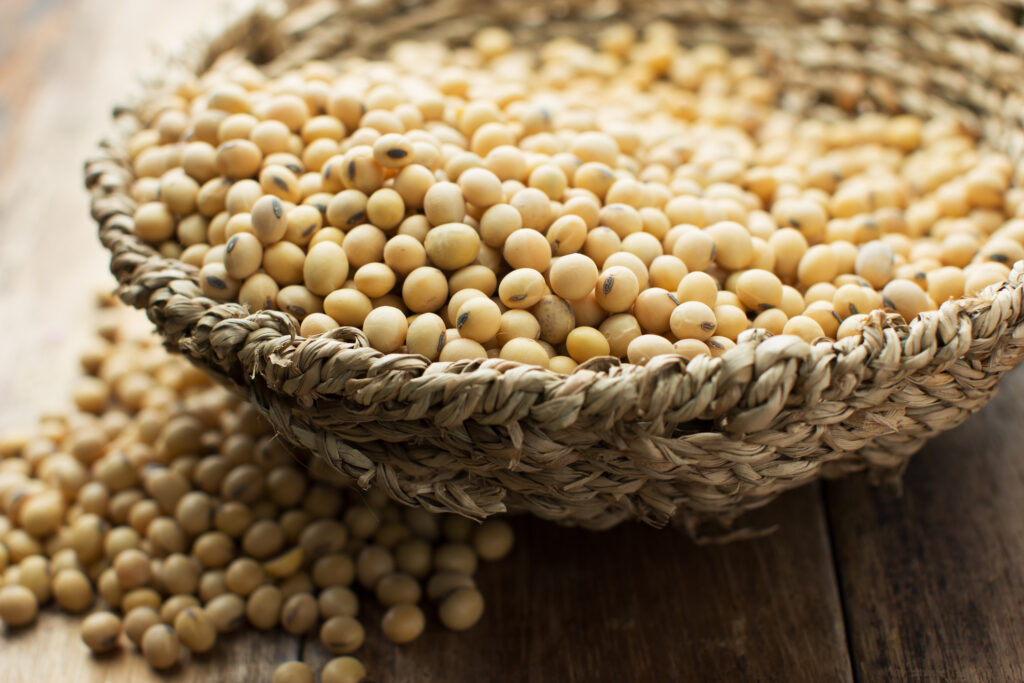
Mixed Results from Other Studies on Phytoestrogens & Menopause
Not every study on phytoestrogens and menopause has seen such striking results. Some trials where women added soya-rich foods — such as soya muffins, soya flour, or soya protein — haven’t found much difference in hot flush frequency or severity compared with a placebo.
For example, in one study where participants ate soya and flaxseed muffins, there was no significant improvement in symptoms compared with the control group.
Similarly, studies using soya flour in generalshow little to no change in hot flushes or overall menopause symptoms.
That doesn’t mean soya foods can’t help — but it does suggest the type of soya food and the overall diet it’s part of may make a difference. It may be that soya works best when eaten regularly, in less processed forms (like tofu, tempeh, or edamame), and as part of a broader pattern of eating rich in plants and fibre.
Why Women Respond Differently to Phytoestrogens During Menopause
It’s clear that not all women respond in the same way, even when eating similar amounts of phytoestrogens. Some notice real improvements, while others feel little or no change. One possible explanation is gut health: certain gut bacteria can convert soya isoflavones into a more active compound called equol — but only some women have the right microbes to do this. Differences in genetics, lifestyle, and overall diet quality are also likely to play a part in shaping how effective phytoestrogens feel from person to person.”
Even if adding more soya or other phytoestrogen-rich foods doesn’t reduce hot flushes for you, there are still really important reasons to include them.
Studies suggest that eating around 25 g of soya protein (2 servings soya foods a day) a day can help lower LDL cholesterol (‘bad’ cholesterol) by a few percent — usually in the range of 3–5%. That might not sound huge, but even small drops in cholesterol can make a real difference for heart health over time.
It’s also worth remembering that soya is most powerful when it’s part of a bigger picture. The Portfolio Diet — which has some of the best evidence for lowering cholesterol — starts with the usual heart-healthy foundations: cutting back on saturated fat, and eating plenty of vegetables, fruit, and wholegrains. On top of that, it adds in specific foods like soya protein and together these layers can add up to a much more meaningful effect than any single food could achieve on its own
How Much Phytoestrogen Do You Need to Make a Difference in Menopause?
Most women eating a typical Western diet get very little in the way of phytoestrogens — usually just a few mg of isoflavones a day. By contrast, many research studies on phytoestrogens and menopause that have shown benefits used around 50 mg daily. That’s roughly the amount found in traditional Asian diets, where soya foods are eaten much more regularly.
Not everyone notices the same effects, even at these higher amounts. As already highlighted some women have microbes that can turn soya isoflavones into the more active compound equol, while others don’t. Genetics, lifestyle, and overall diet quality can also influence how noticeable the effects of phytoestrogens in menopause are.
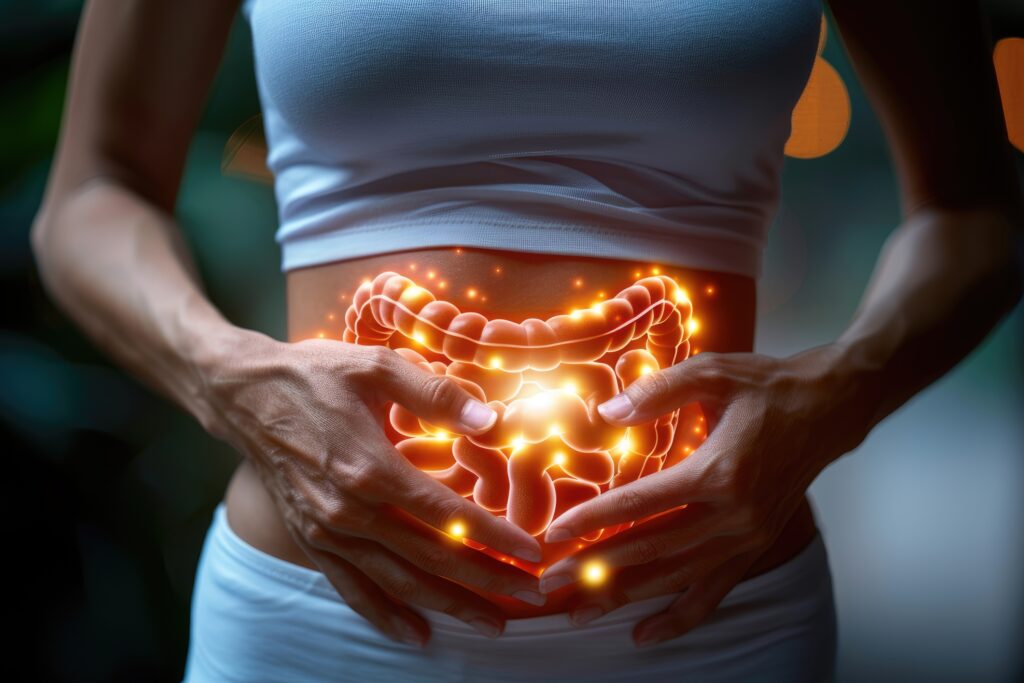
Putting It into Practice: Simple Ways to Eat More Phytoestrogens
Two servings of soya foods a day — for example, a glass of soya milk and a portion of tofu or edamame — usually provide around 40–50 mg of isoflavones, which is right in the range used in many studies. Adding 1–2 tablespoons of ground flaxseed is a simple way to boost your intake of lignans too.
A Day on a Plate: How to Eat More Phytoestrogens in Menopause
- Breakfast → Porridge topped with 1 tbsp ground flaxseed and berries
- Lunch → Salad with edamame beans and wholegrains
- Snack → Smoothie made with soya milk
- Dinner → Stir-fry with tofu or tempeh and plenty of vegetables
Together, that adds up to around 40–60 mg of isoflavones plus a generous boost of lignans — right in line with the amounts used in many studies.
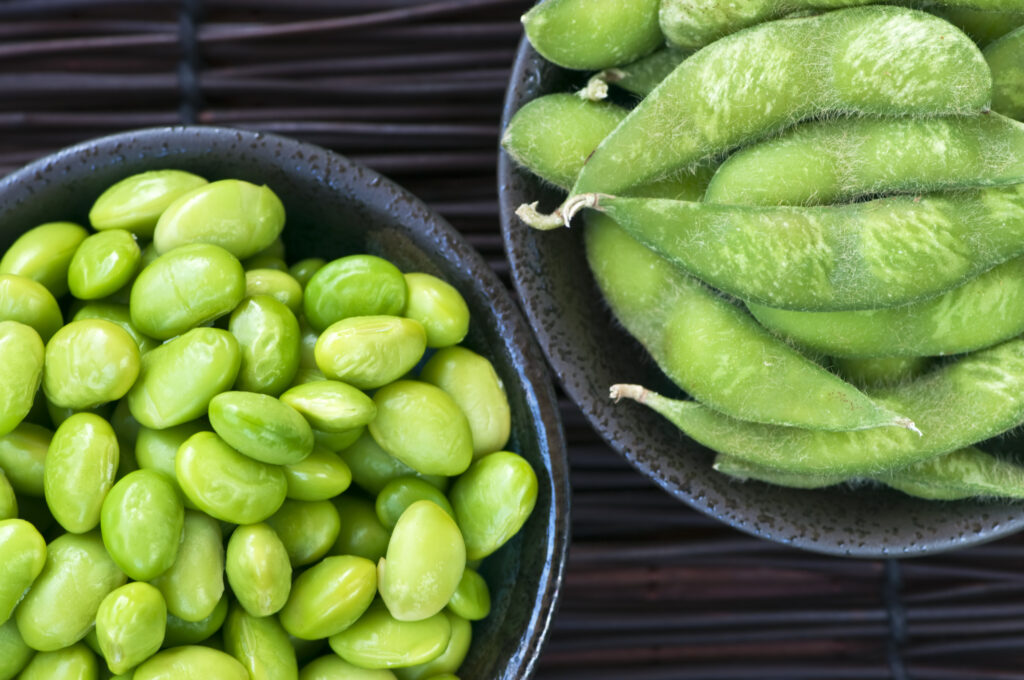
Are Phytoestrogen Supplements Effective (and Safe)?
Evidence from Studies
Alongside foods naturally rich in phytoestrogens, there are also supplements — usually concentrated extracts from soya or red clover.
These have been tested in quite a few studies, but the results are mixed. Some trials have shown benefits, while others haven’t. It’s hard to draw firm conclusions because the studies vary so much in terms of dose, duration, and how outcomes are measured.
Why Food First Matters
Supplements can seem appealing for their convenience, but they don’t bring the wider nutritional benefits of whole foods — like the fibre, protein, and heart-healthy compounds you get from tofu, soya milk, edamame, or flaxseed. That’s why many experts recommend food first.
Safety Considerations
It’s also worth remembering that some supplements provide much higher doses of phytoestrogens than you’d get from food alone.
That doesn’t automatically make them unsafe, but it does mean it’s worth being cautious.
Reviews from the European Food Safety Authority (2015) found that while short-term use of soya isoflavone supplements seems safe for most people, we still don’t know as much about the long-term effects or their interactions with prescribed medications. So, if you’re thinking about taking an isoflavone/phytoestrogen supplement it’s best to have a chat with your doctor first.
Conclusion
Phytoestrogens — or plant oestrogens — aren’t a cure-all, and not every woman will notice a big change in their menopause symptoms like hot flushes or night sweats.
But the evidence on phytoestrogens and menopause suggests they can make a difference for some — and even if they don’t, soya and other phytoestrogen-rich foods still bring valuable benefits for heart health, cholesterol, and overall wellbeing.
The bottom line? They’re a safe, nourishing addition to most diets and worth experimenting with as part of a wider approach to managing menopause symptoms.
Phytoestrogens and Menopause: FAQs
Are phytoestrogens the same as HRT?
No. Phytoestrogens are plant compounds that act much more weakly than the oestrogen in HRT, and they work in a slightly different way. That’s why their effects are usually gentler.
How long before they work?
If they’re going to help, most women notice changes within 6–12 weeks. Like many diet and lifestyle approaches, the effects tend to build gradually rather than happening overnight.
Any side effects to watch for?
Most women tolerate phytoestrogens well. Occasionally they can cause mild bloating or stomach upset, especially if you add them in suddenly or in large amounts.
Are supplements better than food sources?
Food first is best. Whole foods like tofu, soya milk, tempeh, or flaxseed provide phytoestrogens along with protein, fibre, and other heart-healthy nutrients. This is why they are often recommended as part of a balanced menopause diet. Supplements may help some women, but they should only be used with medical advice — especially if you’ve had a hormone-sensitive cancer.
Don’t soya foods cause cancer?
This is a common worry, but the research actually points in the opposite direction:
- Shanghai Breast Cancer Survival Study (2009): higher soya intake was linked to lower recurrence and mortality.
- 2019 meta-analysis (35 studies): soya consumption was associated with reduced risk of breast cancer and improved survival.
- Leading cancer organisations state research in humans has found “no effect or possibly reduced risk” of breast cancer with soya consumption.
Overall: whole soya foods are considered safe — and may even be protective. High-dose supplements, however, should be used much more cautiously.
Making changes in midlife doesn’t have to feel overwhelming. If you’d like some personalised support to get clear on what will truly help your habits, health, and weight, take a look at my Work With Me page to see how we can work together.